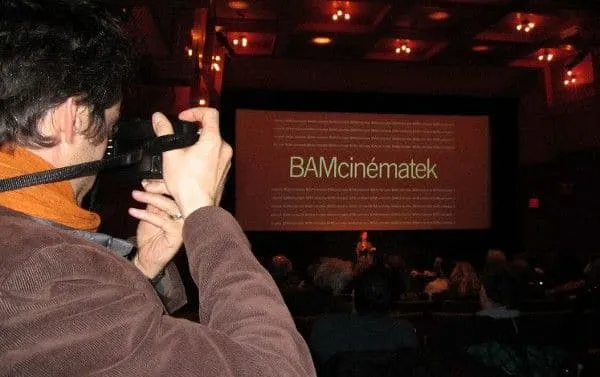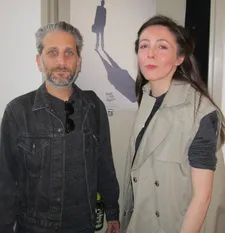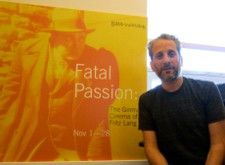 |
| Mathieu Demy at BAMcinématek for his film Americano Photo: Anne-Katrin Titze |
Michael Sládek's film BAM150 is a treasure chest filled with interviews of Maggie Gyllenhaal, Peter Brook, Isabella Rossellini, Laurie Anderson, Mark Morris, Robert Wilson, William Forsythe and Wim Wenders at BAMcinématek for his film Pina. With clips of performances from Pina Bausch to Merce Cunningham, Sládek intimately chronicles the first 150 years of the Brooklyn Academy of Music (BAM). Even Roman Polanski acknowledged the importance of BAM to signal Brooklyn in his 2011 Carnage, starring Christoph Waltz, Jody Foster, Kate Winslet, John C. Reilly.
At BAM, I spoke with the director on the challenges of making a film combining performance with historical background. Traces of Stanley Donen's On the Town and the Berliner Ensemble's The Threepenny Opera start the journey.
Anne-Katrin Titze: Simply following Sandy [Sawotka, BAM's Director of Publicity] to get to her office for this interview, I thought to myself that I wouldn't find my way out of here alone, the maze of the giant machine of BAM. In the film you show the belly of the machine, the people who iron the clothes before the performances, for example.
Michael Sládek: Exactly. The same with the history. Major names, from Mark Twain to Merce Cunningham, to Presidents that have come here, but it comes down to the singular moments.
AKT: Apropos, at the very start of your film, you show the security guard waking up going to work. I thought about Donen's On the Town (1949), the dockworker stretching, when the three sailors (Gene Kelly, Frank Sinatra, Jules Munshin) arrive in the harbor.
MS: Yeah, yeah, I didn't think about that. That's a great connection.
 |
| Michael Sládek and Anne-Katrin Titze with Max von Sydow poster at BAM. Photo by Sandy Sawotka. Photo: Sandy Sawotka |
AKT: It's like the companies coming to BAM. They are the sailors coming for shore leave.
MS: Getting into this, for me was all about big things and small things. BAM is one of those places where you have those giant stages. But they also do those very minimalist things that are maybe just about a gesture or what direction someone's wrist is in - these small artistic moments that happen on these giant stages. The concept came from the minimal and the giant at the same time. That's why we start with the guy who comes in the morning to unlock the door, turn on the lights, get the place going and then it comes alive and turns into this giant machine.
AKT: You were given access to capture performances up-close during rehearsals.
MS: That was one of the main reasons I agreed to do the movie. There was a tiny budget and the crunch time was outrageous. But I got to go behind the scenes, as long as they agreed.
AKT: Did anybody say no?
MS: We didn't approach everyone. Usually these giant productions only run a week. We had to sit down, myself with the BAM folks and say, okay, I want theatre, I want opera, I want dance, I want music. So let me have a cross section. Some European companies wanted to make sure, nobody was making money off it and we had to do some sweet talking and there were some delays. On the other hand, Robert Wilson's company literally let me stand with a small camera during a performance of The Threepenny Opera at the side of the stage. I mapped it out so I wasn't in people's way.
AKT: The Threepenny Opera is the first performance you show in your movie. Was that chronologically the first?
MS: It wasn't chronological, but that one actually did open the season. The ticket sales went through the roof. I have seen a lot of Robert Wilson's stuff, but there is no better pairing than Brecht, Weil, and Wilson. I come from a theater background.
AKT: Your love for theatre shows in the documentary.
MS: I grew up doing theatre. That was my first love. I did straight theatre, I did musical.
AKT: I was impressed with your editing. It is such a huge endeavor to put 150 years of an institution like BAM into one feature length film. How much do you show of an individual performance? What music goes where? Can you talk about your decision making?
MS: Joe Krings, who did the editing with me [and who is also editor for Shannon Plumb's Towheads] - we are old friends, we worked on a lot of projects together, mostly with him editing and me directing. We had nine months from the day we signed the contract with BAM to the day we had to deliver the film. We were shooting throughout the whole period. The way we worked it was, Joe did the first passes on the history sections and I did the first passes on the cinema verité sections, the current BAM. It was really collaborative.
AKT: It flows nicely.
MS: Thank you. To be totally honest, I gave Joe the harder job. I mean, not just 150 years of history, boiling that down - and not just the history of BAM, but the history of Brooklyn as well. It's so important with the whole integration of society, the politics of Brooklyn versus Manhattan, to hone that down to a few minutes was a tough job. I got the more fun job of taking in the performances and behind-the-scenes.

AKT: You got some great quotes. Some of my favorites are from Peter Brook. I did a workshop with him many years ago. He looks a bit like Chaplin now in the interviews.
MS: Yeah, like an old Chaplin. That was by far one of the best things. I wish we had more time with him. He is a huge hero of mine. I read all of his books, I have been in love with his work since I was a college kid. Everything from what he is saying to just the quality of his voice and the quality of his being is amazing. We actually shot that interview before we even signed the contract with BAM to make the movie.
AKT: He talks about the decrepit nature of the Harvey Theater and about the way ruins attract people. For BAM, the history shows itself in the building. The concept of the inertia of the real. You only see time when it is manifest in an object. Capturing a performance on film, it can be endlessly repeated. Can you talk about the relationship between live theatre and film for you?
MS: You are hopefully catching something that seems as if it's only happening now. [Peter] Brook wrote about dead theatre as theatre that isn't about this moment, the sort of static, religious moment. I think we all have seen theatre or opera, or film that's dead - there's something nice about it but it doesn't capture some ecstatic moment. Harvey Lichtenstein discovered the Harvey theater, but he discovered it for Brook. Just walking past that boarded-up place every day, and then discovering this amazing theatre that nobody uses. It was built, I believe, as a movie house. Now, even Maggie Gyllenhaal says in our interview how it kept this amazing energy, as if it soaked up that kind of history. It seems older than it is. Brook came in and said - keep it like this. Part of it is fake, it only looks like it is falling apart, which is brilliant. The lie to tell the truth.
AKT: Maggie Gyllenhaal has another great quote about the Harvey: "this place doesn't suffer fools". Isabella Rossellini brings up another issue, when you come to live in New York from Europe, BAM is the place to catch up with European theatre. You can see what you missed.
MS: Now they built this new theatre, which is even more intimate. It's a black box. You can do anything there. [Jerzy] Grotowski would probably be fine with it, who would never do anything at the Opera House.
AKT: Would you be interested in doing theatre here?
MS: Oh God, no one has asked me!
AKT: Maybe someone will read it here and make you an offer.
MS: I would love to do it, are you kidding? I've been concentrating on film for so long. Doing this film was a stark reminder of how much I miss being in the theatre. There is a different reality, much more of a tightrope with the audience out there.
AKT: You only have to think of the difference seeing a Pina Bausch performance live and the Wim Wenders film, let's say. Even though I really liked his use of 3D.
MS: Sure. It's not the same energy. Film is not the same risk. In film you work it and rework it and rework it. In theatre you are doing that in front of everyone. It's interesting. I run into a lot of film people who don't like going to the theatre, that don't like theater. I always find it baffling. If you are going to the theatre you are investing more. It's also riskier for an audience, than it is to see a movie. William Forsythe talks about it in our film, how the audience really is a part of what's going on. I think a lot of filmmakers would benefit from seeing more theatre.AKT: I agree completely. I remember people behind me in the audience during Bill Forthythe's wonderful Kammer/Kammer here at BAM whispering furiously "What is this? What did you make me go see?"
MS: It's kind of great. When people get angry, at least it's something. He probably would love that.
AKT: You show a number of posters. Did you position them in your shots? You used the one right behind you. The Fatal Passion of Fritz Lang.
MS: A lot of them, yes. This is a great poster and I love that film, I love M. If there were posters in the hallways, we tweaked it a little.
AKT: And you kept the tweaking in the movie, which is an interesting choice. It's funny when you show the people with the expression on their face saying, okay, you make us do this again? A little Brechtian documentary alienation.
MS: Why not? I think documentary is as much an art form of interpretation as anything. There's a lot in this film that's fly-on-the-wall, meetings we captured. And why not let's see these posters as well?
AKT: Did you notice at the beginning of Roman Polanski's Carnage (2011), he used a BAM program at Jody Foster's desk? To make the Brooklyn apartment constructed outside Paris look more Brooklyn?
MS: That's right. I remember it. Another thing about going out to experience art - museums these days are doing great business. People love to go and see art, the same art they can see on their computers. They want to see it hung on a wall with other people there, as a sort of religious experience. I think theatre and even film, especially when you go out and watch it in a movie theatre, can be that sort of religious experience, especially maybe for people that aren't so religious.
Upcoming at BAM:
BAMcinématek presents Cassavetes from July 6 - July 31.
A comprehensive retrospective of films directed by and starring John Cassavetes. Each film in the series will screen on 35mm, starting with the confrontational Opening Night, starring Gena Rowlands and Cassavetes.





















